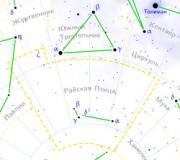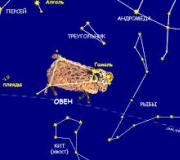Construction of a terrain profile. Constructing a terrain profile along a given line Which of the profiles is built correctly
Construction of a terrain profile
Construct a profile of the terrain along line A - B. To do this, transfer the basis for constructing the profile to answer form No. 2, using a horizontal scale of 1 cm 50 m and a vertical scale of 1 cm 5 m. Indicate the position on the profile with an “X” well with a wind engine.
The construction of a profile should begin with the construction of coordinate axes. According to the conditions of the problem, the horizontal profile scale of 1 cm 50 m is twice as large as the map scale. This means that any distances transferred from the map to the profile will be doubled.
We measure the distance between points A and B on the map. The distance on the map between points A and B is 4 cm, that is, the length of the horizontal axis of the profile will be 8 cm.
The construction of a profile should begin with the construction of coordinate axes.
Point A is located between the horizontal lines 140 and 145 m (since the horizontal lines are drawn through 5 meters). Closer to the horizontal is 140 m, so its height is approximately 142 m. Note the position of point A on the left vertical axis.
Determine the position of the starting and ending points of the profile
Note the position of point A on the left vertical axis.
Determine the position of the starting and ending points of the profile
Point B is located on a horizontal line of 155 m. Mark point B on the right vertical axis.
The horizontal line closest to point A along the profile line has a height of 145 m. The distance to it is 3 mm. In this way, the coordinates of the next point on the profile line become known. It has a height of 145 m and is located at a distance of 6 mm from the left vertical axis.
Determine the coordinates of the next point along the profile line
The next point on the profile line has a height of 145 m and is located at a distance of 6 mm from the left vertical axis.
Determine the coordinates of the next point along the profile line
The next horizontal line along the profile line has a height of 150 m and is located at a distance of 6 mm from point A on the map. Thus, the coordinates of the next point on the profile line become known. It has a height of 150 m and is located at a distance of 12 mm from the left vertical axis.
Determine the coordinates of the next point along the profile line
The next horizontal line along the profile line has a height of 155 m and is located at a distance of 24 mm from point A on the map. Thus, the coordinates of the next point on the profile line become known. It has a height of 155 m and is located at a distance of 48 mm from the left vertical axis.
Determining the coordinates of a well with a wind turbine
The well is located at an altitude of approximately 156.5 m (in the immediate vicinity we see the absolute elevation of the city of Golaya 156.9. The well is located at a distance of 31 mm from point A on the map. Thus, the coordinates of the well become known. It is located at an altitude 156.5 m and is located at a distance of 62 mm from the left vertical axis.
Connecting the obtained dots
When constructing a profile, it should be remembered that the greater the distance between the horizontal lines, the less the surface slope and the less steep the slopes become.
The smaller the distance between the horizontal lines, the greater the surface slope and the steeper the slopes become.
Municipal budgetary educational institution secondary school No. 6 of the city district of Uryupinsk, Volgograd region Using an algorithm for constructing a terrain profile Ruzaeva Irina Viktorovna, geography teacher MBOU Secondary School No. 6 Construct a terrain profile along line A - B. To do this, transfer the basis for constructing the profile to Answer form No. 2, using a horizontal scale of 1 cm 50 m and a vertical scale of 1 cm 5 m. Indicate the position of the spring on the profile with an “X”. 1 2 3 4 5 6 7 We attached the edge of a sheet of paper to the line connecting the given points, marked with lines the horizontal lines through which our direction passes, signing their marks. 155 m 150 m 145 m 150 m 145 m 1 2 3 6 4 155 150 145 5 145 7 150 145 Construct a profile of the terrain along the line AB, using a horizontal scale of 1 cm 50 m and a vertical scale of 1 cm 10 m. Indicate on the profile with an “X” the position of the geodetic sign 214.0. Construct a profile of the terrain along line A-B, using a horizontal scale of 1 cm 50 m and a vertical scale of 1 cm 10 m. Indicate the position of the geodetic sign 218.5 on the profile with an “X” sign. Algorithm for constructing a terrain profile 1. Read the task carefully 2. Pay attention to the scale of the plan and the scale of the future profile, how many meters the horizontal lines are drawn through 3. Draw a profile line on the map (route of movement from A-B) 4. Determine the distance in centimeters between the points , calculate what distance on the ground it corresponds to 5. Draw this distance on a sheet of paper to the required scale. 6. Attach a strip of paper to it, transfer the places of the contours to its edge with short lines, number and sign their heights 7. Sign on the strip of paper at the horizontal lines the heights corresponding to the heights of the contours on the map 8. From all points indicating the intersection of the profile line with marks the heights of the contours, omit the perpendiculars 9. Connect the intersection points with a smooth line, which will depict the terrain profile Additional recommendations 1. To complete the task of constructing a profile using a topographic map, first determine the numerical values of the contours (the height of each contour in meters), then the distance between these horizontal lines along profile line 2. It should be remembered that rivers always flow in depressions of the relief. In the direction towards the river, the heights will decrease (descent), in the direction from the river - they will increase (ascent) 3. If it is indicated that the contours are drawn through 5 meters, therefore, the heights of the contours will differ by “5”; if it is indicated that the horizontal lines are drawn through 2.5 meters, the heights of the horizontal lines will differ by “2.5” 4. For convenience, segments of 1 cm vertically can be divided in half, and then each segment in half again
The twenty-eighth task of the Unified State Exam in geography involves working with maps and plans of the area. It is necessary to build a terrain profile along straight line AB; on the profile you also need to indicate with a symbol any object shown on the map.
Instructions for building a profile
In order to construct a profile, you need to draw a profile line connecting points A and B, and attach to it the edge of a sheet of paper, on which you need to mark the horizontal lines through which line AB passes. The contour marks need to be signed (the map indicates at what interval they are drawn, the value of one contour is also given, so it is not at all difficult to sign them). This edge of the sheet must be attached to the horizontal line on the form where the profile is being constructed. You need to transfer the marks you made to it like this, drawing perpendiculars to the vertical line in similar values:
After this, the resulting points need to be connected with a smooth curved line. This will be the relief profile. In this task, it is important to take into account the scale: if, for example, according to the map scale, 1 cm is 100 m, and in our drawing, 1 cm should be 50 m, then we will mark the distance between two adjacent verticals twice as large. People are often asked to mark a spring on their profile; as a rule, it is located between two adjacent heights - in this case they need to be connected not by a straight line, but by a concave one.
Analysis of typical options for task No. 28 of the Unified State Exam in geography
First version of the task
Construct a terrain profile along line AB. Transfer the basis for its construction to answer sheet 2, using a horizontal scale of 1 cm = 50 m and a vertical scale of 1 cm = 5 m. Mark the position of the spring with an “X”.
The finished profile for this condition looks something like this:

The length of the horizontal line is approximately 80 mm, the distance from the vertical to the spring is approximately 29 mm. The slope in section 1 should be steeper than in section 2. If all these conditions are met and the shape of the profile is similar to the standard, the student receives 2 points for this task. If the profile is similar to the standard, but the distance and steepness of the slopes do not coincide with the specified parameters, 1 point is given. In other cases, no points are awarded for task 28.
A terrain profile is a vertical section of the terrain, constructed at two different scales: horizontal and vertical. The construction of profiles from maps is necessary for various studies of the natural conditions of the territory, for solving scientific and practical problems. For example, using a profile, you can determine whether there is mutual visibility between two points on the ground. By constructing profiles in a number of directions emanating from a given point, it is possible to map areas of the terrain that are invisible from this point (the so-called fields of invisibility), etc.
Let it be necessary to construct a terrain profile along the line specified by points 186.9 and C (Fig. 34).
To do this, transfer the indicated line onto graph paper using a meter (i.e., the point of intersection of the line with the horizontal lines: 1, 2, 3 ...), thereby maintaining the scale of the map. On the line on graph paper, points 1, 2, 3 ... 11 are marked (Fig. 35), as well as characteristic points of the relief - inflections of the terrain (points 5 and 9, Fig. 35). The constructed line is called the base of the profile.
The profile base can be constructed in another way (without a meter).

To do this, you need to attach a strip of clean paper 1.5 - 2 cm wide to the line on the map and transfer to it (making marks with a pencil) points 189.6, 1, 2, ...5, ...9, ...11, N. Then Place a strip of paper on graph paper (along the line) and transfer these points onto it, making marks with a pencil and signing the numbers of the points and their marks, which are transferred from the map.
At all points identified on the basis of the profile, perpendiculars are restored and segments corresponding to the heights of these points are laid on them in the selected vertical scale. The heights of characteristic points 5 and 9 are determined analytically (§16). The resulting points (the ends of the ordinates) are connected by a broken line. To make the profile more expressive, its vertical scale is 10 or more times larger than the map scale (horizontal). To prevent the ordinates from being too long, the marks of all points are reduced by the same amount (in Fig. 35 the marks of the points are reduced by 150 m).
Area Measurement
The areas of terrain areas need to be known to solve many engineering, technical and economic planning problems. Measuring the areas of terrain using topographic maps (plans) can be done graphically, analytically and mechanically.
When measuring the area of a site on a map, its projection onto the horizontal plane (S) is first found, and then the actual area (Sph) on the physical surface of the Earth is determined using the formula
S f = S / cosn avg, (34)
where n cf is the average angle of inclination of the area of a plot of land relative to the horizontal plane (projection plane).
Task: build a profile according to the plan between two points, for example: from a well to a spring. Vertical scale: 1cm 10m, horizontal scale: 1cm 100m. 1. Pay attention to the scale of the plan (1 cm 100 m) and the horizontal scale of the future profile (1 cm 100 m). Let's look at an example if the scales are the same.


3. Opposite each mark, write the height of the horizontal line; to do this, you need to pay attention to how many vertical meters the horizontal lines are drawn on the plan (usually this is signed under the scale of the plan) and remember that the top numbers of the signed contour lines indicate where the terrain is rising, and the bottom of the numbers, where it is falling .





Since our scale is 2 times larger, we will lay out the horizontal distance between two adjacent horizontal lines 2 times larger. the distance from point A to the nearest horizontal line (145 m) on a piece of paper the distance from point A to the nearest horizontal line (145) on the profile, plotted twice


 Additional tips: 2. Once you mark a point, cross it out so you don’t have to remember every time which point you should apply. 3. For convenience, you can divide 1 cm segments vertically in half, and then again each segment in half = 2.5 mm. Since the horizontal lines are drawn every 2.5 m, it turns out very convenient. 1. When applying points, it is more convenient if you use a ruler
Additional tips: 2. Once you mark a point, cross it out so you don’t have to remember every time which point you should apply. 3. For convenience, you can divide 1 cm segments vertically in half, and then again each segment in half = 2.5 mm. Since the horizontal lines are drawn every 2.5 m, it turns out very convenient. 1. When applying points, it is more convenient if you use a ruler






